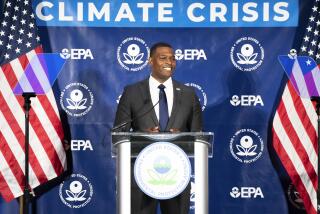EPA Chief Makes Appeal to White House : U.S. Action Urged to End CFC Use
- Share via
WASHINGTON — Responding to concern about the ozone layer, Environmental Protection Agency Administrator William K. Reilly called on the White House on Thursday to adopt a policy seeking to end the use of ozone-depleting chemicals by the end of the century, according to Administration officials.
The proposal, made during a meeting of the Domestic Policy Council, came just hours after a surprise agreement by members of the European Community to take similar action.
If endorsed by President Bush, the move would double the pace at which production and consumption of chlorofluorocarbons or CFCs--the household gases that are destroying the Earth’s ozone layer--would be restricted under U.S. law.
First Step in Effort
EPA officials see the proposal as a first step in a wider effort to strengthen the Montreal Protocol, an international agreement signed by about 40 nations that calls for a 50% reduction in production and consumption of CFCs by 1999.
The agreement was hailed as historic when it was signed in November, 1987, but the discovery since that time that the ozone depletion problem was far worse than imagined has led to wide spread concern that the treaty was not sufficiently strict.
Since the treaty was signed, scientists have reported that during part of the year, the ozone levels in the stratosphere over Antarctica decline by nearly 50% and that the ozone layer over parts of the Northern Hemisphere have been depleted since 1969 by as much as 6%.
In addition, scientists warned last month that accumulations of the man-made pollutants high above the North Pole had left the ozone layer in the Arctic stratosphere “primed” for destruction.
An EPA official said Thursday night that Reilly hoped for an Administration decision on the proposal as early as today, when he leaves for London to attend a 100-nation conference.
The talks, headed by British Prime Minister Margaret Thatcher, will deal with the threat to the ozone layer.
White House approval would give U.S. negotiators attending the meeting a head start in seeking revision of the Montreal Protocol, which is due to be officially reconsidered for the first time in May at a meeting in Helsinki.
CFCs are used as coolants in refrigerators and air conditioners and as propellants in some spray cans. When in the atmosphere, they break down into chemical components capable of destroying ozone at a rapid rate. The process is exacerbated in the polar regions because of cold temperatures and other meteorological characteristics.
Ozone, which is found in the stratosphere between 9 and 15 miles above the Earth’s surface, shields the planet from the sun’s harmful ultraviolet rays.
Researchers believe that a mere 1% depletion in the ozone layer can increase the risk of skin cancer by 4% to 5%.
At the London meeting, European and U.S. negotiators hope to persuade less-developed nations, including China and India, to restrict their CFC production. Neither nation has yet signed the Montreal Protocol.
But the European decision Thursday and the Reilly proposal to the White House represent decisions by the developed nations to proceed with efforts to end CFC production even if other nations do not follow their lead.
More to Read
Sign up for Essential California
The most important California stories and recommendations in your inbox every morning.
You may occasionally receive promotional content from the Los Angeles Times.













